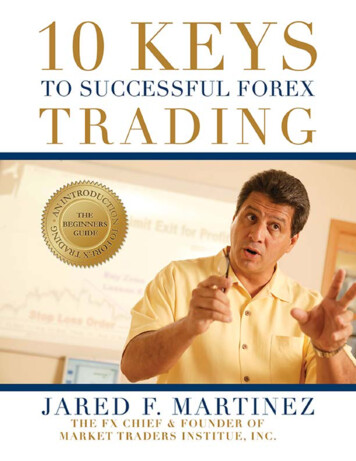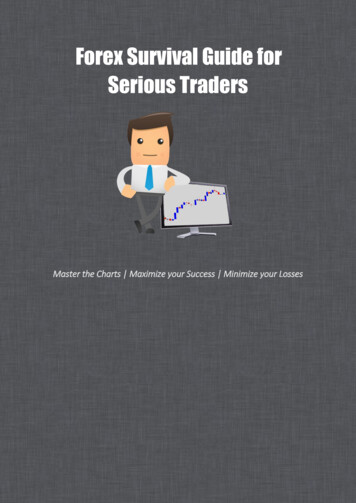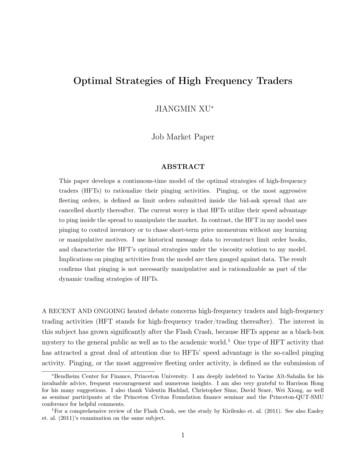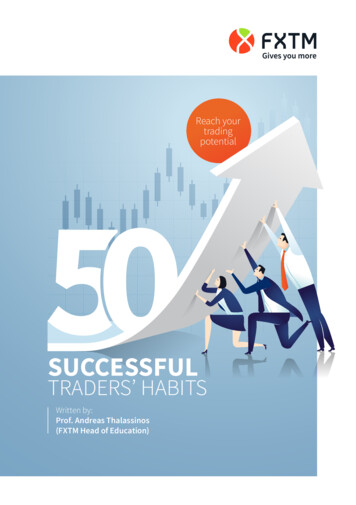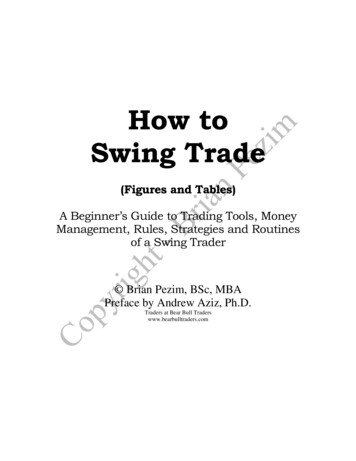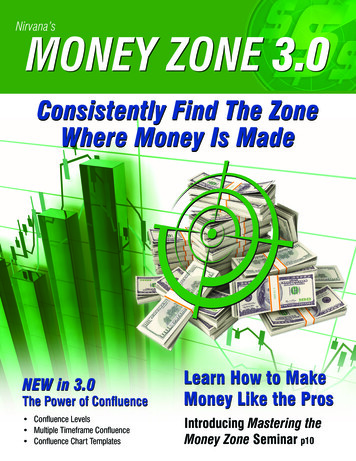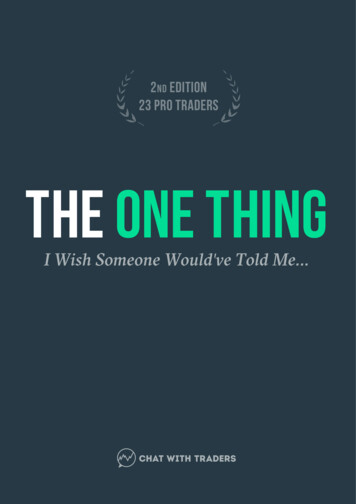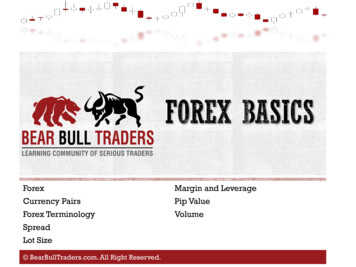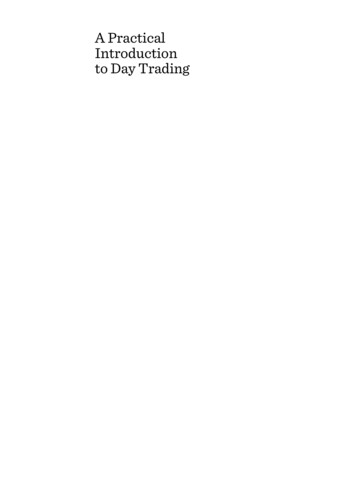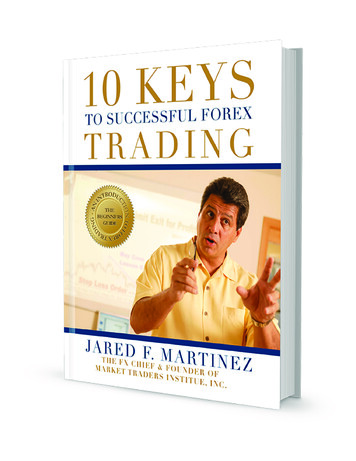
Transcription
te’sTheUltimateTradersPackage: 16indepth,interactiveeducationmodules Videomentorshipspackedfullofwisdom from professionalsinthefield redknowledge training: Participateindailybroadcastshostedbyateam ofForexanalysts UltimateTradersPackage.m a rk e ttra d e rs.co m
A Beginner's Guide to the Forex:The 10 Keys to Successful TradingByJared F. MartinezVisit Market Traders Institute’s - Forex Home Study CoursesWebsite: MARKETTRADERS.COMMarket Traders Institute, Inc.400 Colonial Center Parkway, Suite 350Lake Mary, Florida, 32746(407) 740 0900 US - Toll Free - (800) 866 7431Legal Notices: The 10 Keys to Successful Trading 1998 - 2012.ALL RIGHTS RESERVED: No part of this book may be reproduced or transmitted in any form by any means,electronic or mechanical, including photocopying, recording or by any information storage or retrieval systems,without the express written permission from the author and publisher. All materials contained herein have beencopyrighted. Reproduction will be in violation of all Copyright Laws. Violators will be prosecuted.While attempts have been made to verify the accuracy of information provided in this manual, neither the authornor the publisher assumes responsibility for errors, inaccuracies or omissions.There are no claims by the Author, Jared F. Martinez, or Market Traders Institute, Inc., ForexTips.com or any of itsdirectors, employees, and affiliated instructors that the trading strategies or methodologies in this manual willresult in profits and will not result in losses. This manual is not a guarantee to produce profits. Currency trading onthe FOREX and trading results in general vary from individual to individual and may not be suitable for everyone.All strategies, techniques, methodologies and trades contained in this manual should not be construed as aninvitation to enter and trade in the market.Each trader is responsible for his or her own actions. Your downloading of this manual confirms your agreementwith the Statement of Risk, constitutes your agreement to this disclaimer, confirms and exempts the author,publisher and Instructors from any liabilities or litigation. 2012 Market Traders Institute, Inc.1
Your Constant CompanionI am your constant companion.I am your greatest helper or heaviest burden.I will push you onward or drag you down to failure.I am completely at your command.I am managed with care—you must be firm with me. Show me exactly how you want somethingdone, and after enough lessons, I will do it automatically.I am the servant of all great people and, alas, of all failures.Those who are great, I have made great.Those who are failures, I have made failures.I am not a machine, though I work with the precision of a machine and the intelligence of aperson. You may run me for profit or run me for ruin—it makes no difference to me.Take me, train me, and be firm with me, and I will place the world at your feet. Be easy with meand I will destroy you.Who am I?I am habit! Author Unknown2
Table of ContentsIntroduction A Trader's Mission and Goal Level of Traders0404Chapter One: What is the Forex? Foreign Exchange Market Roles of Commercial Banks Advantages of Forex Trading050506Chapter Two: Reading Candlestick Charts Bullish Candlestick Formations Bearish Candlestick Formations Neutral Candlestick Formations Reversal Candlestick Formations10121314Chapter Three: Types of Orders Market Orders Limit Orders Stop Orders One Cancels the Other Cancel/ Replace Orders18181919193
IntroductionA Trader's Mission and GoalIt is the mission of the trader to become a long-term, financially successful trader. This can be achievedwhen the trader adopts and accepts The 10 Keys of Successful Trading. A trader must commit to live bythree disciplines to become a successful trader.Three Disciplines of Successful TradersA trader must believe in The 10 Keys to Successful Trading and merge them into theirpersonality. Success depends on creating a trading plan, and maintaining the discipline to TRADETHAT PLAN!2. A trader must be committed to Continuing Education. Study technical analyses and thepsychology of successful trading. A trader must make logical decisions, void of emotions, whiletrading. Learn to trade in control!3. A trader must map out a sensible equity management plan to ensure a Return On Investment.Trade no more than 20% of a Margin Account and expose no more than 5% of that account onany single trade.1.Levels of TradersLevel OneBeginner Trader - Studies and paper trades for a minimum of one month with pretend currency, gainingthe experience required to establish a track record of profitable performance.Level TwoAdvanced Beginner - Trades one or two lots with real money, learning to overcome emotions and at thesame time, establishes a track record of making money.Level ThreeCompetent Trader - Trades with control over their emotional distractions. Utilizes proper equitymanagement and achieves a positive financial return.Level FourProficient Trader – Trades with confidence, education and experience. Achieves positive financialreturns.Level FiveExpert Trader - Instinctively executes profitable trades without emotion.4
Chapter 1What is the Forex? Forex Foreign Currency ExchangeYou can trade 24-hours a dayThe Forex is larger than all other financial markets COMBINEDThe Foreign Exchange (Forex) Market is a cash, or “spot”, interbank market established in 1971 whenfloating exchange rates began to materialize. This market is the arena in which the currency of onecountry is exchanged for those of another, and where international business is settled.The Forex is a group of approximately thousands of currency trading institutions that includeinternational banks, government central banks, and commercial companies. Payments for exports andimports flow through the Foreign Exchange Market, as well as payments for purchases and sales ofassets. This is called the “Consumer Foreign Exchange Market.” There is also a “speculator” segment inthe Forex Market. Speculators have great financial exposure to overseas economies participating in theForex to offset the risks of international investing.Historically, the Forex Interbank Market was not open to small speculators. With a previous, minimumtransaction size, and often stringent financial requirements, the small trader was excluded fromparticipation in this market. Today, Market Maker brokers are allowed to break down the largerinterbank units and offer small traders the opportunity to buy or sell any number of these smaller units(lots).Commercial Banks play two roles in the Forex Market:(1) They facilitate transactions between two parties. For example, two companies wishing to exchangedifferent currencies would seek the help of a commercial bank.(2) They speculate by buying and selling currencies. The banks take positions on certain currenciesbecause they believe they will be worth more if, “long”, or less if, “short”, in the future. It has beenestimated that international banks generate up to 70% of their revenues from currency speculation.“Other” speculators include many of the worlds’ most successful traders, like George Soros.The Forex also includes central banks from various countries, like the U.S. Federal Reserve. Theyparticipate in the Forex to serve the financial interests of their country. When a central bank buys andsells its own or a foreign currency, the purpose is to stabilize their own country’s currency value.The Forex is so large and is composed of so many participants, that no one player, not even thegovernment central banks, can control the market. In comparison to the daily trading volume averagesof the 300 billion U.S. Treasury Bond market and the approximately 100 billion exchanged in the U.S.stock markets, the Forex is huge, and has grown in excess of 4 trillion daily.The word “market” is a misnomer describing Forex trading. Unlike other markets, there is not acentralized location for trading activity. Currency trading takes place via the Internet or over the phone.5
A large portion of Forex trading is done by large, international banks. These banks will processtransactions for large companies, governments and their own accounts. These banks continually provideprices (“bid” to buy and “ask” to sell) for each other and the broader market. The market’s current priceof a particular currency is the most recent quotation from one of these banks. The “live” priceinformation is reported through a variety of private data reporting services and is able via the Internet.There are numerous advantages to trading on the Forex.LiquidityIn the Forex Market, there is a buyer and a seller! The Forex absorbs trading volumes and per trade sizeswhich dwarf the capacity of any other market. On the simplest level, liquidity is a powerful attraction toany investor. It suggests the freedom to open or close a position 24 -hours a day.Once purchased, many other, high-return investments are difficult to sell at will. Forex traders don’thave to worry about being “stuck” in a position due to lack of market interest. In the nearly 3.5 trillionU.S. per day market, major international banks have “bid” (buying) and “ask” (selling) prices forcurrencies.AccessThe Forex is open 24 hours a day from about 5:00 PM ET Sunday to about 4:00 PM ET Friday. Anindividual trader can react to news when it breaks, rather than having to wait for the opening bell ofother markets when everyone else has the same information. This timeliness allows traders to takepositions before the news details are fully factored into the exchange rates. High liquidity and 24 hourtrading permit market participants to take positions, or exit, regardless of the hour. There are Forexdealers in every time zone and in every major market center; Tokyo, Hong Kong, Sydney, Paris, London,United States, et al. willing to continually quote "buy" and "sell" prices.Since no money is left on the market table-referred to as a “Zero Sum Game” or “Zero-Sum Gain”- andproviding the trader picks the right side, money can always be made.Two-Way MarketCurrencies are traded in pairs–for example: Euro/Dollar (EUR/USD), Dollar/Yen (USD/JPY) orDollar/Swiss Franc (USD/CHF). Every position involves the selling of one currency and the buying ofanother. If a trader believes the Swiss Franc will appreciate against the Dollar, the trader can sell Dollarsand buy Francs. This position is called "selling short".If one holds the opposite belief, that trader can buy Dollars and sell Swiss Francs–“buying long”. Thepotential for profit exists because there is always movement in the exchange rates (prices). Forextrading permits the opportunity to capture pips from both rising and falling currency values in relation tothe Dollar. In every currency trading transaction, one side of the pair is always gaining, and the otherside is always losing.LeverageTrading on the Forex is done in currency “lots.” Each lot is approximately 100,000 U.S. dollars worth of aforeign currency. To trade on the Forex market, a Margin Account must be established with a currencybroker. This is, in effect, a bank account into which profits may be deposited and losses may bededucted. These deposits and deductions are made instantly upon exiting a position.6
Brokers have differing Margin Account regulations, with many requiring a 1,000 deposit to “day-trade”a currency lot. Day-trading is entering and exiting positions during the same trading day. For longer-termpositions, many require a 2,000 per lot deposit. In comparison to trading in stocks and other markets,which may require a 50% margin account, a Forex speculators' excellent leverage of 1% to 2% of the 100,000 lot value means the trader can control each lot for one to two cents on the dollar.Execution QualityBecause the Forex is so liquid, most trades can be executed at the current market price. In all fastmoving markets (stocks, commodities, etc.), slippage is inevitable in all trading, but can be avoided withsome currency brokers' software that informs you of your exact entering price just prior to execution.You are given the option of avoiding or accepting the slippage. The Forex Market's huge liquidity offersthe ability for high quality execution.Confirmations of trades are immediate and the Internet trader has only to print a copy of theircomputer screen for a written record of all trading activities. Many individuals feel these features ofInternet trading make it safer than using the telephone to trade. Respected firms such as CharlesSchwab, Quick & Reilly and T.D. Waterhouse offer Internet trading. These companies would not risktheir reputations by offering Internet service if it were not reliable and safe. In the event of a temporarytechnical computer problem with the broker’s ordering system, the trader can telephone the broker 24hours a day to immediately get in or out of a trade.Internet brokers’ computer systems are protected by firewalls to keep account information from pryingeyes. Account security is a broker’s highest concern. They take multiple steps to eliminate any riskassociated with financial transactions on the Internet.A Forex Internet trader does not have to speak with a broker by telephone. The elimination of themiddleman (broker/salesman) lowers expenses, makes the process of entering an order faster, anddecreases the possibility of miscommunication.Execution CostsUnlike other markets, the Forex generally does not charge commissions. The cost of a trade isrepresented in a Bid/Ask spread established by the broker. (Approximately 4 pips)TrendinessOver long and short historical periods, currencies have demonstrated substantial and identifiable trends.Each individual currency has its own “personality,” and offers a unique, historical pattern of trends thatprovide diversified trading opportunities within the spot Forex market.FocusInstead of attempting to choose a stock, bond, mutual fund, or commodity from the tens of thousandsavailable in other markets, Forex traders generally focus on one to four currencies. The most commonand most liquid are the US Dollar, Japanese Yen, British Pound, Swiss Franc, Euro and Canadian Dollar.Highly successful traders have always focused on a limited number of investment options. BeginningForex traders will usually focus on one currency and later incorporate one to three more into theirtrading activities.Margin Accounts7
Trading on the Forex requires a Margin Account. You are committing to trade and take positions today.As a speculator trader you will not be taking delivery on the product that you are trading. As a Stock DayTrader, you would only hold a trading position for a few minutes, up to a few hours, and then you wouldneed to close out your position by the end of the trading session.All orders must be placed through a broker. To trade stocks you would need a stockbroker. To tradecurrencies you will need a Forex currency broker. Most brokerage firms have different marginrequirements. You need to ask them their margin requirements to trade currencies.A Margin Account is nothing more than a performance bond. All traders need a Margin Account totrade. All accounts are settled daily. When you gain profits, they place your profits into your MarginAccount that same day. When you lose money, an account is needed to take out the losses you incurredthat day.A very important part of trading is taking out some of your winnings or profits. When the time comes totake out your personal gains from your margin account, all you need to do is contact your broker andask them to send you your requested dollar amount. They will send you a check or wire transfer yourmoney.8
Chapter 2Reading Candlestick ChartsIn the Seventeenth Century, the Japanese developed a method to analyze the price of rich contracts.This technique was called "Candlestick Charting." Today, Steven Nison is credited with popularizing theCandlestick Chart, and is recognized as the leading authority on interpretation of the system.Candlesticks are graphical representations of the price fluctuations of a product. A candlestick canrepresent any period of time. A currency trader’s software can provide charts representing time framesfrom five minutes, up to one week per candlestick.There are no calculations required to interpret Candlestick Charts. They are a simple visual aidrepresenting price movements in a given time period. Each candlestick reveals four vital pieces ofinformation; the opening price, the closing price, the highest price and the lowest price the fluctuationsduring the time period of the candle. In much the same way as the familiar bar chart, a candle illustratesa given measure of time. The advantage of candlesticks is that they clearly denote the relationshipbetween the opening and closing prices.Because candlesticks display the relationship between the open, high, low and closing prices, theycannot be used to chart securities that have only closing prices. Interpretation of Candlestick Charts isbased on the analysis of patterns. Currency traders predominantly use the relationship of the highs andlows of the candlewicks over a given time period. However, Candlestick Charts offer identifiable patternsthat can be used to anticipate price movements.There are two types of candles: The Bullish Pattern Candle and the Bearish Pattern Candle.A white (empty body) represents a Bullish Pattern Candle.It is used/denotes when prices open near the low price andclose near the period’s high price.A black (filled body) represents a Bearish Pattern Candle.It is used/signifies when prices open near the high price andclose near the period’s low price.9
Bullish Candlestick Formations10
11
Bearish Candlestick Formations12
Neutral Candlestick Formations13
Reversal Candlestick Formations14
Candlestick Example ChartsStock charts can also be interpreted using Candlestick Charts.15
Exercise 1: Circle and identify the Candlestick Formations in the following chart.Exercise 2: Circle and identify the Candlestick Formations in the following chart.16
Answers to the Exercises17
Chapter 3Types of Orders Sellers are ASKing for a high priceBuyers are BIDding at a lower priceTrading is an auctionSlippage occurs with most Market OrdersThe difference between the ASK and the BID price is the SPREAD.A Trader must understand what each order is and what part it plays in capturing pips.A Forex Trader must use three (3) types of orders: a Market Order, a Limit Order, and a Stop Order.The two, primary orders used for entering and exiting the Forex market are Limit and Stop Orders. Oncean order is placed, there are two critical procedures: One-Cancels-the-Other (OCO) and Cancel-andReplace Orders. Properly understanding the procedures of order execution is a vital step to capturingpips.Remember: All good carpenters carry a toolbox. The sharper the tools, and the more skilled thecarpenter is at using them, the more effective they are. The sharper you become as a trader, the moreefficient and lucrative you will be.Market OrdersA Market Order is an order given to a broker to buy or sell a currency at whatever the market is tradingit for at that moment. The Market Order can be an entry order into the market, or an exit order to getout of the market. Traders use Market Orders when they are ready to make the commitment to enter orexit the market. Caution should be exercised when using Market Orders in fast moving markets. Duringperiods of rapid rallies, or down reactions, gains or losses of many points may occur due to slippagebefore receiving the fill.Trading is an auction where there are buyers bidding on what sellers are offering. The bid is the buy andthe offer to sell is the ask.SlippageSlippage is a trade executed between a buyer and seller where the resulting buy or sell transaction isdifferent than the price seen just prior to order execution. On average, one to six pips will be lost withMarket Orders, perhaps more, due to slippage. Market Orders are rarely filled at the exact, anticipatedprice. Market Traders Institute recommends caution when entering or exiting with a Market Order.Limit OrdersLimit Orders are orders given to a broker to buy or sell currency lots at a certain price or better. Theterm "Limit" means exactly what it says. Most of the time, you will buy at that exact limit price or better.Limit Orders are used to enter and exit the market. They are generally used to acquire a specific price,avoid slippage and unwanted order fills (execution price), which can happen with Market Orders.When selling above the market, it is a Limit Order. When buying below the market, it is a Limit Order. ALimit Order will be executed when the market trades through it. Seventy to ninety percent of the time, if18
the market is trading at your Limit Order, it will be executed. The market must trade through yourspecified Limit Order number to guarantee a fill. The trading software provides notification withinseconds of the fill. A trader does not have to call his broker to see if their order has been filled.Stop OrdersStop Orders are orders placed to enter or exit the market at a desired, specific price. When buyingabove the market, it is a Stop Order. When selling below the market, it is a Stop Order. Stop Orders turninto Market Orders when the market trades at that price. Stop Orders, as well as Market Orders, aresubject to slippage, Limit Orders are not.The majority of Stop Orders are used as protective, Stop Loss Orders. These orders are placed with anEntry Order to ensure an exit when the market goes against you. A good trader never trades without aprotective Stop Loss Order. They are orders executed to get you out of the market when your trade hasgone against you. Protective Stops are discussed in depth in the Ultimate Traders Package on Demand.One-Cancels-the-Other (OCO)Whenever entering the market, exiting the market at some future time is required. An OCO order is aprocedure that means "one-cancels-the-other." Upon entering the market, place a protective Stop LossOrder and establish a projected profit target. That projected profit target can be your Limit Order.If you simultaneously place both Limit and Stop Loss Orders when you enter the market, you can OCOthem and walk away from your computer. What does that mean? At some future point in time, eitheryour Stop Order or Limit Order will automatically cancel your opposing order. If the trader is sure abouta trade, they can execute an OCO order and walk away from the trade. The trading software will thenmanage the trade.Cancel/Replace OrdersA Cancel/Replace Order is a procedure and not an Entry or Exit Order. By definition, it is when the tradercancels an existing open order and replaces it with a new order. A Cancel/Replace order is primarily astrategy of trading and predominately used after one has taken a position in the market and wants tostay in the market locking in profit. For example, you buy Swiss at 1.410. Your protective Stop Loss Orderis 1.390. The market moves in the direction you projected. Now, you want to reduce your potential loss.So, cancel your Stop Order at 1.390 and replace it to 1.410 where you got in. You are now in a trade withno risk! As the market moves further North, in your direction, you want to lock in more profit. You cancancel your 1.410 Stop Loss Order and replace it with a new 1.440 Stop Loss Order. You have captured30 pips. You are in an all-win, no-risk trade. Keep canceling and replacing your Stop until you are finallystopped-out. This is discussed separately under "Protective Stops" in the Ultimate Traders Package onDemand.19
Ultimate Traders Package on DemandBoth the novice and the more experienced Forex trader can gain new insights into Forex trading fromthe comprehensive, step-by-step approach of MTI’s Forex training methods.MTI’s Ultimate Traders Package on Demand is a five-phase Forex training program using live, onlineForex training classes in conjunction with home study materials. Through a variety of Forex tools andresources and around-the-clock support from Forex analysts and Education Specialists, students canlearn how to make education trading decisions and build their trading confidence. The Ultimate TradersPackage on Demand includes:16 in-depth online Forex training modules packed full of essential Forex informationTrading challenges and exercises designed to prepare students for the live marketWeekly client-only webinars that includes a LIVE! walk-through of the Forex marketExclusive proprietary trading systems that teaches students to spot market direction andestablish entry and exit positionsWeekly mentorships with the FX Chief where he’ll focus on the psychological aspects of tradingUnlimited access to a variety of archived videos on a variety of Forex topics including Fibonacci,Equity Management and Japanese candlesticks2-Day On-site Forex training workshop lead by a Forex professional to review the lessonscovered in the Ultimate Traders Package on DemandNEW! Auto-Trader Charting Add-On - an exclusive charting add-on that could help you automatetrades between MTI 4.0 Charting software and a demo trading account*.Attend a free demonstration for more information about Market Traders Institute, the Ultimate TradersPackage on Demand, and the trading potential of the Currency Trading industry. Click here to reserveyour spot today!*Currently, this AutoTrader Charting Add-On only interfaces with FXCM demo accounts. More brokerage options will become available in thefuture.20
Market Traders Institute, Inc. 400 Colonial Center Parkway, Suite 350 Lake Mary, Florida, 32746 (407) 740 0900 US - Toll Free - (800) 866 7431 . There are no claims by the Author, Jared F. Martinez, or Market Traders Institute, Inc., ForexTips.com or any of its directors, employees, and affiliated instructors that the trading strategies or .
